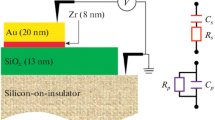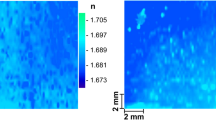Abstract
The electrophysical properties and the resistive switching effect in ITO/SiNx/Si memristor structures have been investigated. A silicon nitride film ~200 nm thick with a Si/N ratio varying with depth has been deposited on a silicon substrate by chemical vapor deposition. The current–voltage characteristics of ITO/SiNx/Si-p structures have shown that the conduction mechanism in a high-resistivity state depends on the properties of the nitride film and is described in terms of the Pool–Frenkel model, which takes into consideration electron hops between neighboring traps. When the polarity of the voltage applied to the structure changes sign, conducting channels in the nitride film break down and the structure switches over to a high-resistivity state. The photoswitching effect has been discovered in the ITO/SiNx/Si structure, which opens up a new frontier for using memristors in silicon optoelectronic devices.




Similar content being viewed by others
REFERENCES
L. O. Chua, IEEE Trans. Circuit Theory 18, 507 (1971). https://doi.org/10.1109/TCT.1971.1083337
D. B. Strukov, G. S. Snider, D. R. Stewart, and R. S. Williams, Nature 453, 80 (2008). https://doi.org/10.1038/nature06932
Y.-H. Liu, T.-C. Zhan, T. Wang, W.-J. Tsai, T.-C. Lu, K.-C. Chen, and C.-Y. Lu, IEEE Trans. Electron Devices 66 (12), 5155 (2019). https://doi.org/10.1109/TED.2019.2949251
A. A. Gismatulin, V. A. Gritsenko, T.-J. Yen, and A. Chin, Appl. Phys. Lett. 115 (25), 253502 (2019). https://doi.org/10.1063/1.5127039
K. A. Nasyrov and V. A. Gritsenko, J. Appl. Phys. 109 (9), 093705 (2011). https://doi.org/10.1063/1.3587452
X. Jiang, Z. Ma, H. Yang, J. Yu, W. Wang, W. Zhang, W. Li, J. Xu, L. Xu, K. Chen, X. Huang, and D. J. Feng, Appl. Phys. 116 (12), 123705 (2014). https://doi.org/10.1063/1.4896552
T. J. Yen, A. Chin, and V. Gritsenko, Sci. Rep. 10, 2807 (2020). https://doi.org/10.1038/s41598-020-59838-y
I. Parkhomenko, L. Vlasukova, F. Komarov, O. Milchanin, M. Makhavikou, A. Mudryi, V. Zhivulko, J. Żuk, P. Kopyciński, and D. Murzalinov, Thin Solid Films 626, 70 (2017). https://doi.org/10.1016/j.tsf.2017.02.027
T. Anutgan, M. Anutgan, I. Atilgan, and B. Katircioglu, Appl. Phys. Lett. 111 (5), 053502 (2017). https://doi.org/10.1063/1.4997029
A. Emboras, I. Goykhman, B. Desiatov, N. Mazurski, L. Stern, J. Shappir, and U. Levy, Nano Lett. 13 (12), 6151 (2013). https://doi.org/10.1021/nl403486x
C. Ríos, M. Stegmaier, P. Hosseini, D. Wang, T. Scherer, C. D. Wright, H. Bhaskaran, and W. H. P. Pernice, Nat. Photonics 9 (11), 725 (2015). https://doi.org/10.1038/NPHOTON.2015.182
A. N. Mikhaylov, A. I. Belov, D. V. Guseinov, D. S. Korolev, I. N. Antonov, D. V. Efimovykh, S. V. Ti-khov, A. P. Kasatkin, O. N. Gorshkov, D. I. Tetelbaum, A. I. Bobrov, N. V. Malekhonova, D. A. Pavlov, E. G. Gryaznov, and A. P. Yatmanov, Mater. Sci. Eng., B 194, 48 (2015). https://doi.org/10.1016/j.mseb.2014.12.029
I. Valov and M. N. Kozicki, J. Phys. D: Appl. Phys. 46 (7), 074005 (2013). https://doi.org/10.1088/0022-3727/46/7/074005
M. R. Boon, Thin Solid Films 11 (1), 183 (1972). https://doi.org/10.1016/0040-6090(72)90357-4
D. V. Gritsenko, S. S. Shaĭmeev, V. V. Atuchin, T. I. Grigor’eva, L. D. Pokrovskiĭ, O. P. Pchelyakov, V. A. Gritsenko, A. L. Aseev, and V. G. Lifshits, Phys. Solid State 48 (2), 224 (2006). https://doi.org/10.1134/S1063783406020053
Funding
This study was performed in the framework of the state research program “Photonics, Microelectronics, and Nanoelectronics.”
Author information
Authors and Affiliations
Corresponding authors
Ethics declarations
The authors declare that they have no conflicts of interest.
Additional information
Translated by V. Isaakyan
Rights and permissions
About this article
Cite this article
Komarov, F.F., Romanov, I.A., Vlasukova, L.A. et al. Resistive Switching Effect of the Structure Based on Silicon Nitride. Tech. Phys. 66, 133–138 (2021). https://doi.org/10.1134/S1063784221010126
Received:
Revised:
Accepted:
Published:
Issue Date:
DOI: https://doi.org/10.1134/S1063784221010126




